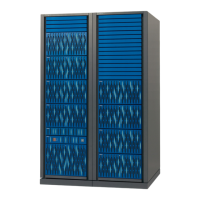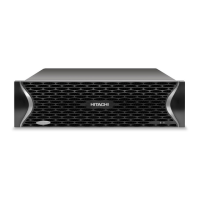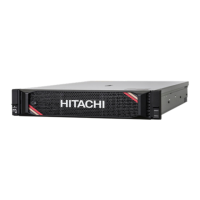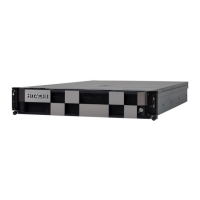CCI adopts the following way with this point in view:
• You must save the signature and volume layout information to the system
disk by using the inqraid -gvinf command, after an S-VOL has set the
signature and new partition by the Windows disk management.
• You can put back the signature by setting the signature and volume
layout information to an S-VOL that was saved to the system disk by
using the inqraid -svinf command, after splitting the S-VOL. If the S-
VOL is created with the Noread option and the system is rebooted, then
the system cannot create a device object (\Device\HarddiskVolume#) and
Volume{guid} for S-VOL, but the -svinf option will create a Device object
(\Device\HarddiskVolume#) and Volume{guid} without using the
Windows disk management.
Note: The Cluster Disk Driver does not allow using the Noread volume as
[Device is not ready] at the boot time, since the Cluster Disk Driver is a Non-
Plug and Play Driver. Verify this situation using the inqraid command as
follows:
inqraid $Phy -CLI
DEVICE_FILE PORT SERIAL LDEV CTG H/M/12 SSID R:Group
PRODUCT_ID
Harddisk0 - - - - - - - -
Harddisk1 - - - - - - - -
In this case, do the following to disable the Cluster Disk Driver:
1. In the Computer Management window, double-click System Tools,
and then click Device Manager.
2. On the View menu, click Show Hidden Devices. Non-Plug and Play
Drivers appear in the list in the right pane.
3. Open Non-Plug and Play Drivers, right-click Cluster Disk, and then click
Disable. When prompted to confirm whether to disable the cluster disk,
click Yes. When prompted to restart the computer, click Yes.
4. Verify that you can see the Noread volume using inqraid command as
follows.
inqraid $Phy -CLI
DEVICE_FILE PORT SERIAL LDEV CTG H/M/12 SSID R:Group
PRODUCT_ID
Harddisk0 CL2-K 61456 194 - s/S/ss 0004 1:01-10
OPEN-3
Harddisk1 CL2-K 61456 256 - s/S/ss 0005 1:01-11
OPEN-3
5. After starting up CCI and splitting the S-VOL, put back the signature by
using the inqraid -svinf command.
6. Again, in the Computer Management window, enable the Cluster Disk
Driver, and restart the computer.
GPT disk for Windows
Windows supports the basic disk called GPT disk using GUID partition instead
of the Signature. The GPT disk also can be used as an S-VOL of
8-10
Examples of using CCI commands
Command Control Interface User and Reference Guide

